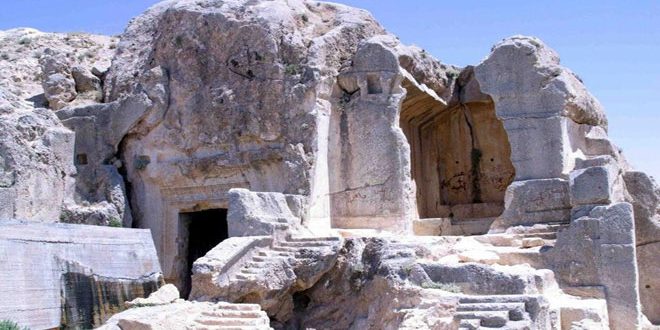Ain Manin, is a peaceful town located in Qalamoun Mountains, 18 kilometers north of Damascus. It is surrounded by several small mountains with the Manin valley between them. Its name was inspired by a spring that used to irrigate the valley which leads to Barzeh and the northern Ghouta areas and is adjacent to the mountain of Mar Takla on the top and the slopes of which several architectural structures are engraved.
Archaeological surveys have confirmed the existence of several monuments in the mountain, including a residential site from the Roman, Byzantine and Islamic eras.
Archeological explorations have revealed that the oldest house in the town, dates back to the Neolithic period (the seventh and sixth millennium BC) and this is proven by the flint tools discovered in a number of caves. The town was also inhabited during the Iron Age in the seventh and fourth centuries BC, according to the Director General of Antiquities and Museums, Dr. Mahmoud Hammoud.
 During this era, Dr. Hammoud said, Ain Manin town was only a small village that contained a few number of houses, adding that despite the absence of clear architectural features, the pottery fractures and other archaeological finds, such as clay dolls, jugs, cups and lanterns, confirm that the site was used as a residence place during this period.
During this era, Dr. Hammoud said, Ain Manin town was only a small village that contained a few number of houses, adding that despite the absence of clear architectural features, the pottery fractures and other archaeological finds, such as clay dolls, jugs, cups and lanterns, confirm that the site was used as a residence place during this period.
The Antiquities Director went on to say that the town prospered greatly during the Roman and Byzantine eras during which housing was concentrated in Mar Takla mountain, whose name was associated with St. Takla, who stayed in the mountain for two days before she continued her way to Maaloula.
 Hammoud made it clear that Mar Takla Mountain contains many structures built and carved in the rock. These structures include, in addition to residential houses, a religious complex consisting of temples that were turned into a monastery and churches during the Byzantine era. On the eastern and southern slopes of the mountain, the remains of archeological buildings and burials are located, Dr. Hammoud said.
Hammoud made it clear that Mar Takla Mountain contains many structures built and carved in the rock. These structures include, in addition to residential houses, a religious complex consisting of temples that were turned into a monastery and churches during the Byzantine era. On the eastern and southern slopes of the mountain, the remains of archeological buildings and burials are located, Dr. Hammoud said.
Regarding the discoveries of archaeological missions on the site, Dr. Hammoud said that important finds dating back to the Byzantine period were discovered, including a metal candlestick base on which ornaments representing a lion’s claw were made, a small metal statue of an eagle opening its wings and bronze coins with pictures of the Byzantine emperors printed on them.


Moreover, Dr. Hammoud said, stone burials and coffins were found in the town in addition to various finds, most important of which was a bronze statue representing the god Eel sitting on its throne and resembling the statues of Ugarit. A head of a statue of rough limestone dating back to the second century AD and representing the goddess Aphrodite was also discovered in addition to a large rock sculpture on which tools for cutting stones were drawn. Ancient dolls, rosaries, coins, pottery vessels and jewelries made of metal, bone and other materials, were also among the finds.
The Roman structures discovered in Ain Manin reflect the prosperity of the town during that period, according to Dr. Hammoud. These structures include four temples, but the names of the gods that these temples were dedicated to are still unknown.
Dr. Hammoud believes that the archeological discoveries affirm the town’s importance in the ancient ages and the level of its development, particularly in the Roman and Byzantine ages.
The Ain Manin site was used for housing in later ages, the Arab Islamic ages, including the Umayyad, Ayyubid and Mamluk eras.
Hamda Mustafa

